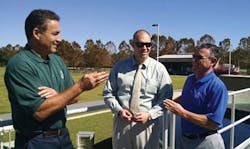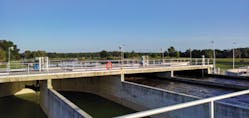By Glenn Burden
The city of Inverness, Fla., is the largest city in Citrus County with a population of more than 7,000 residents. In the mid-2000s, Inverness experienced growth that created a variety of water treatment challenges, which led to a consent order requiring upgrades and expansion of its existing water and wastewater infrastructure.
In 2006, the city undertook an ambitious plan for a municipality its size to upgrade its secondary treatment facility into a SCADA-monitored tertiary treatment facility that would produce public-access reclaimed water and save 700,000 gallons of water per day.
Amid upgrading its wastewater treatment and effluent disposal system, Inverness sought a contract operator that could assist with long-term asset protection and provide excellence in utility operation for the new $22-million upgrade project. The city also wanted to ensure that service would not be disrupted during the upgrade process.
Inverness City Manager Frank DiGiovanni summed up his community's approach: "Our plan was to utilize the latest treatment technologies to produce high-quality reusable water. We also wanted to establish a partnership that would provide us with a team of skilled professionals who routinely operate these types of facilities."
Inverness entered into a five-year partnership with Woodard & Curran (W&C) in 2008, in which the firm would take on all operations and maintenance of the city's water and wastewater services.
Making the Transition to Contract Operations
Contract operators face significant challenges when beginning operations, among them is the need to instill a new working culture with former community employees who join the firm to form the operations team.
"Regarding a contract service provider as a hostile presence diminishes the arrangement's value for both parties," DiGiovanni said. "It was important to us to find a firm that could engage quickly and mesh with our staff."
The operations leadership designed a career path for the staff that would make up the team and utilize their skills in new or different ways. Five city employees made the transition, bringing with them valuable institutional knowledge. In addition, three additional staff members were hired, and a project manager rounded out the team. No jobs were lost in the process.
Another characteristic of any successful public-private partnership is open communication. W&C introduced its corporate management, technical engineers, certified operators, and local support staff to Inverness. Likewise, the city's administration, engineering, finance, personnel, and utilities departments developed relationships and avenues of communication. The operations and management team also attended weekly city staff meetings, provided updates, offered recommendations, and contributed to capital planning efforts as the new wastewater reclamation facility underwent construction.
New Consent Order Creates Challenges
The operations team's preliminary focus was to plan the startup of the new 1.5-million-gallons-per-day (MGD) biological nutrient removal wastewater reclamation facility and guide rehabilitation of the existing water production and distribution system. However, construction on the reclamation facility was almost finished when the city learned that it was being placed under a consent order for exceeding maximum contaminant levels for trihalomethanes and HAA5s (the haloacetic acid family) in the drinking water.
Initial engineering evaluations identified capital-intensive filtration options, including enhanced coagulation/filtration, activated carbon and reverse osmosis. A city the size of Inverness is not in a position to quickly restructure rates and obtain the necessary bonding to fund such systems -- all of which exceeded $2 million. Ozonation was eliminated, in part because of capital requirements but also because the operations team was not convinced that it would succeed as a sole solution to the problem.
This narrowed the options to a chemical solution, and the team selected chloramination as the most cost-effective resolution to the problem. While less costly in terms of construction, operating a chloramination system required additional operations expertise and the development of specific standard operating procedures.
Chloramination accomplishes disinfection through the addition of ammonia. There was concern that this would adversely affect the taste and odor (T&O) of the treated water. Inverness water has very high levels of iron and manganese, which had previously caused issues with T&O. However, studies and feedback from utilities that had already experienced these issues indicated that chloramination could improve water quality aesthetics. Within five months, compliance was achieved with the addition of chloramination. As an added benefit, resident complaints about T&O were reduced by 95 percent.
Converting to chloramination involved adding a Foxcroft FX1000-Pon-line total chlorine residual meter, an ammonia skid with two feed pumps, a day tank with a digital scale, and a new feed line to the existing 500,000-gallon storage tank, which was rehabilitated by installing a new 2,200-gallon-per-minute aerator. The storage tank was cleaned and the exterior was painted to match the water plant and branded with the city's logo.
Additional activities included increased flushing at critical points of the system; rewinding motors and replacing bearings in high-service pumps; replacing the treatment facility's control system; renovating the chlorine feed system to improve monitoring and analysis; and managing the replacement of the fluoride feed system.
Chloramination can create its own set of problems if dead-end lines are not eliminated or flushed regularly. Operators must plan to commit a lot of attention to the front end of this kind of process and must think through many permutations involving flows, water chemistry and equipment dosage controls, as well as how to best use staff to effectively flush and monitor the system each day for the first two weeks of operation.
Starting Up the New Facility
Meanwhile, team members cleaned and refurbished the wastewater treatment building and existing assets. The digester and sludge thickening tank were reconditioned without taking the plant off line. The two effluent storage ponds were also cleaned and disinfected. Employees learned how to operate the new sludge dewatering system after the existing RBC unit was demolished and removed. In addition, the team rewrote standard operating procedures, performed a thermography scan to find electrical hot spots, upgraded the master lift station's electronic controls, and established a repair schedule and preventive maintenance plan.
Additional efforts were required to rehabilitate the city's 32 wastewater lift stations, some of which had suffered serious physical, mechanical and electrical deterioration over a 30-year life span. Minor electrical failures and clogged pumps also led to frequent alarms. To remedy this situation, the operations team inspected and cleaned all of the pump stations, and several were replaced. Alarms immediately decreased by 25 percent, and after one year, by 80 percent.
Leading up to the startup of the new facility, the team maintained effluent compliance by working closely with the site engineer and contractors and constantly kept city officials and the general community up-to-date on the project. The team also focused on learning the new reclamation facility's systems before startup.
"The learning curve can be steep for individuals without broad wastewater experience," said John Sowka, facility manager at the new site. Training sessions were scheduled for one to four hours per day, at least three to four days per week, within the two months before formal startup.
The final task was the tie-in of the influent flow from the old plant to the new. The team had three concrete saws on hand to prevent a major spill or lift station overflow in the event that the first two saws failed. The job was completed within two hours without a break in service.
Community Benefits
The new 1.5-MGD tertiary treatment facility started up and met compliance standards within its first minutes of operation.
The reclaimed water facility reduces the city's need to draw groundwater by over 70 percent. Inverness sends the reclaimed water to irrigate a nearby golf course and park. The total cost of the facility was about $17 million, including $2.2 million to build the pipeline and pump station to the golf course. The city received approximately $12 million in grant funding for the project. The facility services 4,500 residential and commercial entities with the capability to service thousands more.
Today, the city and its staff are still experiencing benefits. Former city employees who were indifferent to pursuing certification are now enthusiastic about the prospects of an expanded career path. The team continues to be directly involved in capital planning and implementation, proving that public and private workforces can effectively collaborate to tackle and resolve multiple problems and opportunities. In 2014, the reclamation facility received the Florida Water Environment Association's David W. York Award, which is given to honor excellence in developing and maintaining water reuse systems.
About the Author: Glenn Burden is the Florida Area Manager for Woodard & Curran. He has over 20 years of experience in the management, operations and maintenance of wastewater treatment facilities and eight years of experience in the management, transmission and distribution of reclaimed water for public access reuse and recharge of the Floridan aquifer.
More WaterWorld Current Issue Articles
More WaterWorld Archives Issue Articles






